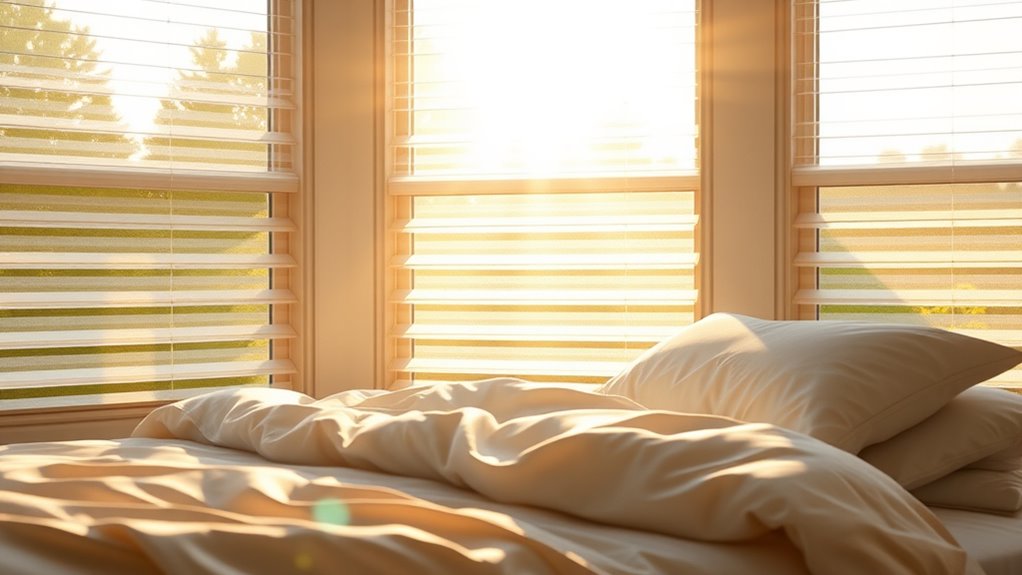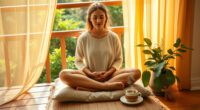Morning light helps set your internal clock, improving your sleep quality and mood. When you get sunlight early in the day, it signals your brain to synchronize your circadian rhythm, reduces melatonin, and boosts serotonin. This not only deepens your sleep at night but also enhances alertness and emotional well-being. By understanding how morning light works, you can optimize your routines for better rest and mental health — there’s more you can explore ahead.
Key Takeaways
- Morning light exposure helps synchronize circadian rhythms, promoting regular sleep-wake cycles.
- It suppresses melatonin production, increasing alertness during the day and facilitating better sleep at night.
- Natural morning light boosts vitamin D, supporting overall sleep quality and immune health.
- Consistent exposure to morning light improves sleep onset, duration, and reduces nighttime awakenings.
- Light therapy and smart lighting can be personalized to enhance circadian alignment and sleep health.
How Light Influences Our Biological Clocks
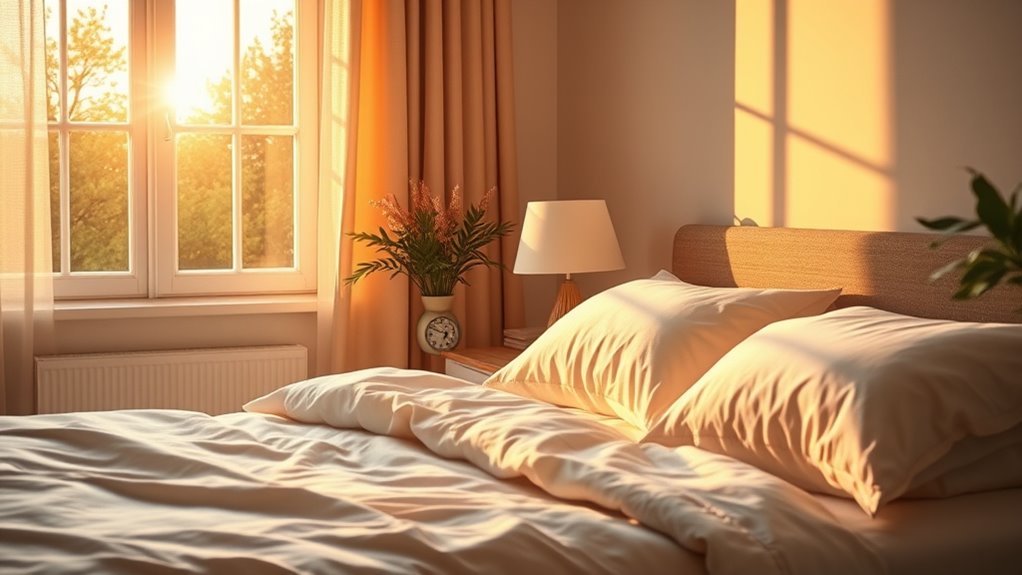
Light plays a crucial role in controlling your body’s biological clock, known as the circadian rhythm. The suprachiasmatic nucleus (SCN), located in your hypothalamus, contains internal clock genes that send signals to regulate sleep, hormones, and other bodily functions. When light enters your eyes, it influences the SCN’s signaling, aligning your internal clock with day and night. Even during sleep, light can pass through your eyelids, impacting this process. The SCN’s sensitivity varies throughout the day, being most responsive in the morning and evening. Morning light exposure shifts your clock earlier, helping you feel sleepy and wake up sooner. Conversely, evening light delays your rhythm, making sleep and wake times later. This regulation ensures your body stays synchronized with the natural light-dark cycle. Understanding the biological clock] can help optimize your light exposure for better sleep health.
Psychological Advantages of Morning Illumination
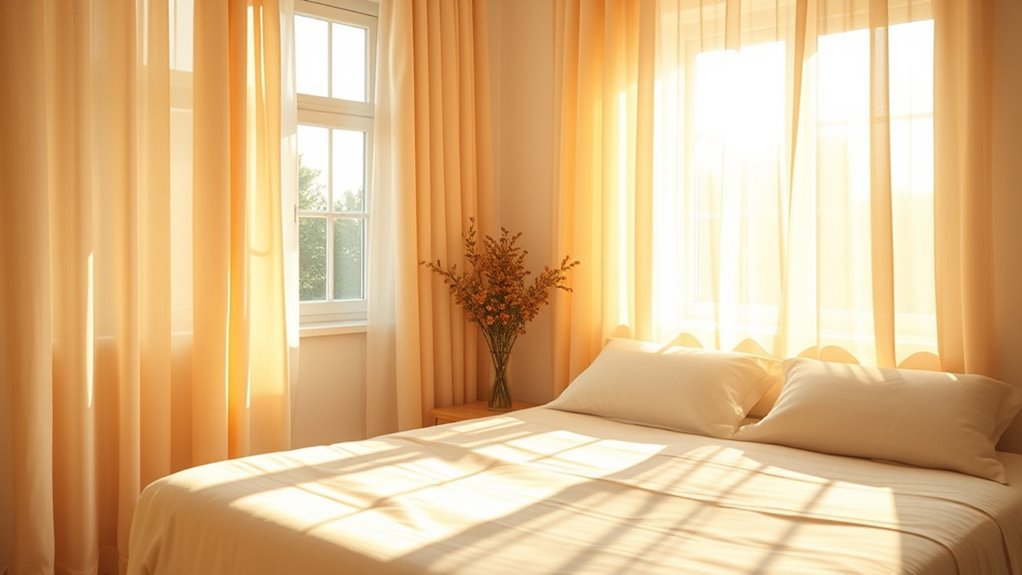
Experiencing morning illumination offers vital psychological benefits that can enhance your overall well-being. Exposure to early sunlight boosts serotonin, improving your mood and reducing feelings of depression. It also helps manage stress by releasing hormones that counter emotional pain, promoting a calmer mindset. Morning light supports emotional resilience, fostering a positive mood and better mental health. It influences neurotransmitter balance, which is essential for maintaining stability in your emotional state. Additionally, light exposure helps regulate your circadian rhythm, leading to improved sleep patterns and mental clarity. By enhancing mood and reducing stress, morning illumination strengthens your psychological resilience, making it easier to handle daily challenges. The role of light quality and its impact on mental health underscores the importance of natural morning light. Furthermore, consistent exposure to morning light can reinforce your body’s natural sleep-wake cycle, contributing to more restful sleep overall. Overall, starting your day with sunlight can notably uplift your emotional and mental state. A well-regulated suprachiasmatic nucleus ensures your internal clock remains aligned with natural light cues, further supporting mental health. Additionally, exposure to sunlight can influence the production of vitamin D, which has been linked to mood regulation and mental health benefits.
Practical Strategies for Harnessing Morning Light

To effectively harness morning light, timing and consistency are key. Aim to get at least 20 to 30 minutes of natural light within the first hour after waking, ideally near sunrise when red and blue wavelengths are most beneficial. Even on cloudy days, longer outdoor exposure helps maintain the benefits. Reduce sunglasses use in the morning so natural light reaches your retina and resets your internal clock. To maximize your exposure, consider these activities:
- Take a walk or jog outdoors close to sunrise
- Eat breakfast outside or near a sunlit window
- Position your workspace near natural light sources
- Incorporate sunlight into your morning routine with stretching or meditation
- Use light therapy boxes when outdoor sunlight is limited
- Be aware of AI safety measures and ongoing research to ensure your health routines remain aligned with the latest scientific insights.
- Incorporating light exposure into your daily routine can further enhance your circadian rhythm regulation. Additionally, understanding how hormonal responses to light influence sleep can help you optimize your morning routine for better rest.
Scientific Evidence Supporting Morning Light Benefits

Scientific research confirms that morning light exposure produces tangible health benefits by regulating your body’s internal clock. It helps synchronize your circadian rhythms, which are essential for maintaining a consistent sleep-wake cycle. Exposure to morning sunlight suppresses melatonin, the sleep hormone, making you alert during the day, while increasing cortisol levels boosts your energy and focus. Additionally, morning light stimulates vitamin D production, supporting immune health and mental well-being. Studies also show that regular sunlight exposure improves sleep quality, enhances mood, and promotes deeper sleep stages. Moreover, this natural light helps stabilize hormonal balance and biological cycles, reducing stress and inflammation. Incorporating light therapy can be an effective way to maximize these benefits, especially during winter months or in regions with limited sunlight. Furthermore, the benefits of morning light extend to protective styling, as it encourages healthier hair practices by reducing the need for harsh chemicals or heat styling. For example, exposure to natural light can also positively influence scalp health and hair growth by supporting scalp circulation. Overall, scientific evidence underscores that consistent morning light exposure is a simple, effective way to boost your overall health and sleep.
Emerging Trends and Future Research in Light Therapy
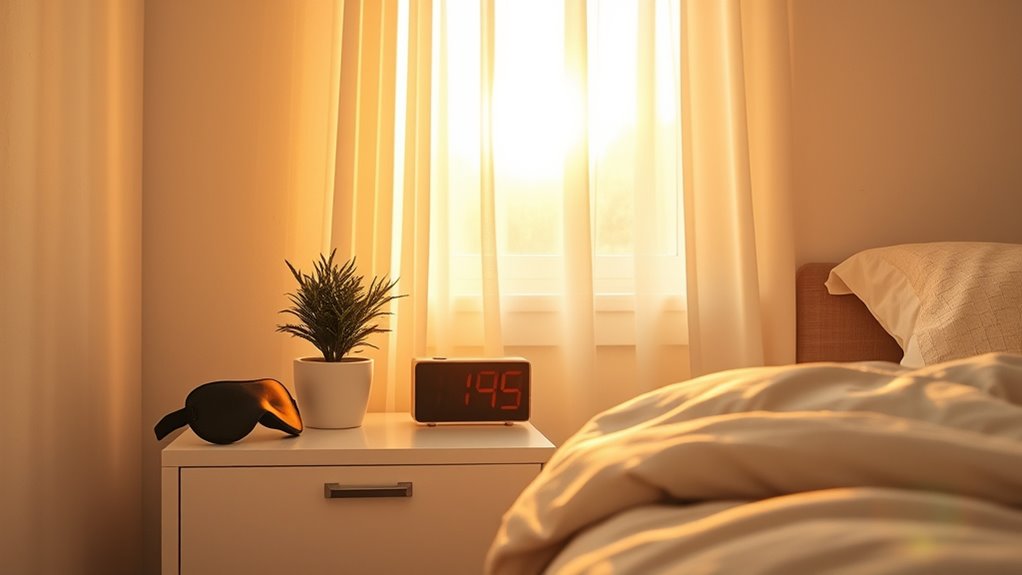
Emerging trends in light therapy are shaping a more personalized and integrated approach to optimizing circadian health. You’ll see a focus on tailored treatments like red light therapy (RLT), which targets specific wavelengths to influence melatonin and sleep quality, though studies show mixed results due to timing and individual differences. Combining light therapy with sleep syncing helps align your schedule with your natural rhythms, boosting sleep and overall health. Morning blue light is increasingly used for older adults, offering a non-drug option to enhance sleep and activity. Researchers are also refining protocols for circadian disorders, utilizing portable devices and digital monitoring. Future research aims to clarify ideal exposure schedules, explore combined therapies, and develop innovative tech solutions for personalized circadian care. Additionally, understanding PlayStation support hours and other entertainment park schedules can help optimize leisure time around sleep routines, promoting better overall well-being. The integration of light therapy protocols with wearable technology is expected to advance personalized treatments, ensuring more effective and targeted circadian health management. Advances in light exposure schedules and the development of smart lighting systems are also contributing to more effective circadian interventions, making it easier to incorporate proper lighting into daily life. Moreover, incorporating knowledge from juice cleansing research may inspire new ways to support metabolic health alongside circadian therapies. Ongoing studies are also investigating how chronotherapy can be fine-tuned for diverse populations to maximize benefits.
Frequently Asked Questions
How Does Age Affect Sensitivity to Morning Light for Sleep Regulation?
Did you know that over 55, your eyes transmit about 30% less blue light? This decline reduces your sensitivity to morning light, which helps regulate your sleep-wake cycle. As a result, you might need brighter or longer exposures to morning light to stay in sync. Despite these changes, your circadian clock still responds to light, so increasing morning sunlight can improve your sleep and overall well-being.
Can Artificial Indoor Lighting Replicate the Benefits of Natural Morning Sunlight?
You wonder if artificial indoor lighting can match natural morning sunlight’s benefits. While typical indoor lights fall short in intensity and spectral quality, specialized circadian lighting systems can help. They mimic natural light by providing blue-enriched, high-intensity light during the day, promoting alertness and better sleep. However, most standard indoor lighting isn’t enough. To truly replicate natural sunlight’s benefits, you need high-quality, tunable lighting that adjusts in intensity and spectrum throughout the day.
What Are the Potential Risks of Excessive Morning Light Exposure?
You might think more morning light is always better, but too much can backfire. Excessive exposure can disrupt your circadian rhythm, leading to sleep issues and increased health risks like heart disease and metabolic problems. It can cause eye strain, headaches, and neurological discomfort. When you overdo it, your body’s natural balance gets thrown off, so moderation is key to reap benefits without inviting trouble.
How Does Geographic Location Influence Optimal Timing for Morning Light Therapy?
Your geographic location considerably influences the best timing for morning light therapy. If you’re west within a time zone, you might need to delay your exposure to match later sunrise times. Higher elevations and seasonal changes also shift ideal times. By considering local sunrise patterns and adjusting your schedule accordingly, you can improve circadian alignment, enhance sleep quality, and get the most benefit from light therapy tailored to your specific geographic environment.
Are There Specific Dietary Factors That Enhance the Effects of Morning Light on Sleep?
You might wonder if certain foods can boost morning light’s sleep benefits. Consuming high-carb meals, especially with whole grains and vegetables, can help you fall asleep faster and improve sleep quality. Eating foods rich in zinc, tryptophan, or melatonin—like fatty fish, cherries, or kiwi—may also support better sleep. Avoid caffeine late in the day, as it can interfere with sleep, diminishing the positive effects of your morning light exposure.
Conclusion
By embracing the power of morning light, you unveil a secret weapon against sleepless nights and restless days. Imagine waking up feeling unstoppable, energized, and ready to conquer anything just because you stepped into the sunlight. Don’t miss out on this life-changing gift—morning light isn’t just a simple habit; it’s your ticket to transforming every aspect of your life. Start tomorrow, and watch your world change in ways you never thought possible.
